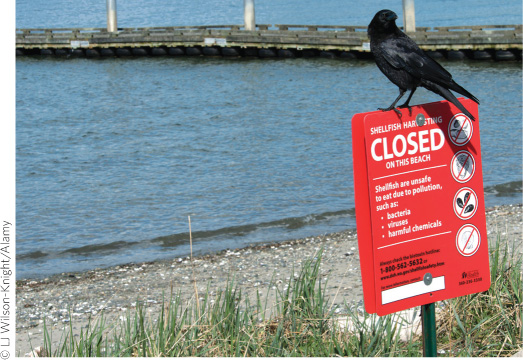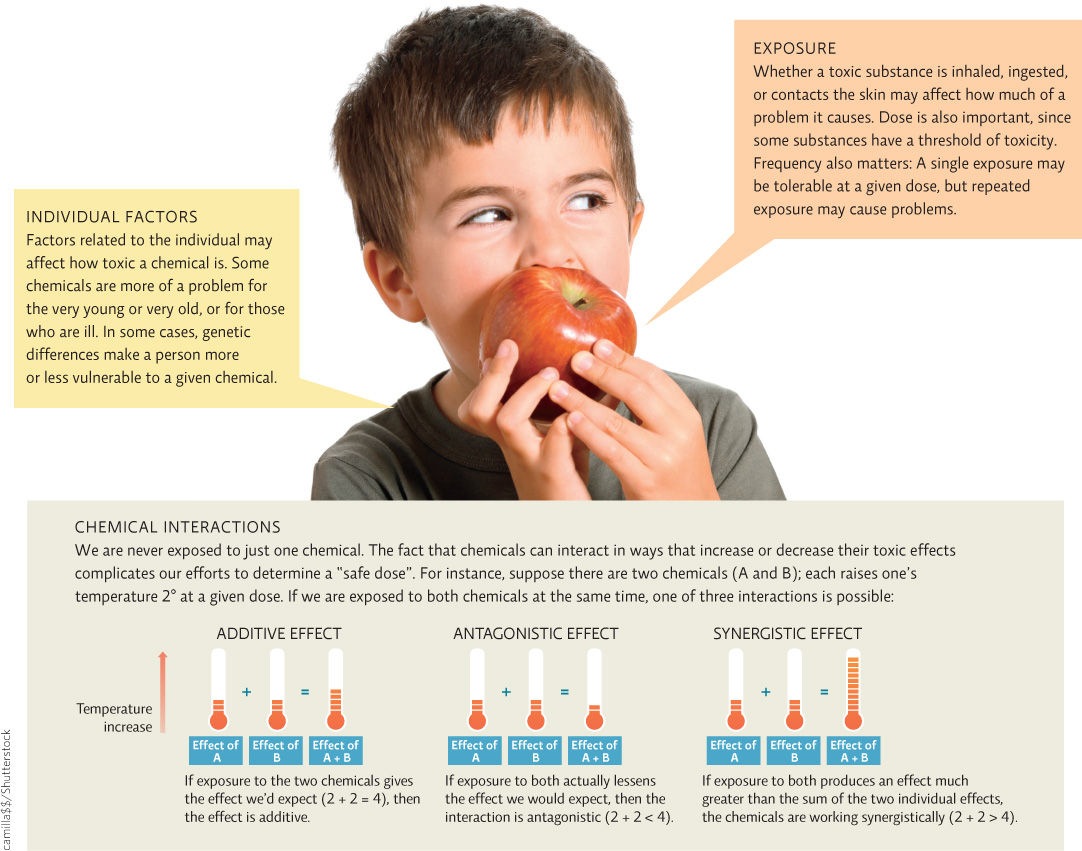What are the dangers presented by toxics, and how do we determine safe exposure levels?
In the wake of the National Toxicology Program’s 2008 report, a team of scientists at the Centers for Disease Control and Prevention (CDC) analyzed more than 2,000 urine samples collected from a statistically representative cross section of the American population. More than 90% of those samples tested positive for BPA; the average concentration was 2.6 parts per billion (ppb), though the top 5% of samples had an average concentration of almost 16 ppb. That’s well past the amount of BPA known to cause harm in rodents. Concentrations seemed to decrease with age, so that children had more BPA in their systems than adolescents, and adolescents had more than adults. “This study really laid to rest any doubts about whether or not BPA was in fact leaching from our food containers into our bodies,” says Vogel. But did that necessarily mean that BPA was dangerous to humans?
Any given toxic substance has several characteristics we must consider when evaluating its safety. One such characteristic is its persistence—how long it takes the substance to break down in the environment. Chemicals with low persistence tend to break down quickly, especially in the presence of sunlight. Chemicals with high persistence tend to linger for a long time and can affect ecosystems well after their initial release.
persistence
The ability of a substance to remain in its original form; often expressed as the length of time it takes a substance to break down in the environment.
KEY CONCEPT 3.4
How hazardous a substance is depends on its persistence, solubility, and toxicity to cells. Interactions with other chemicals may alter toxicity, making it difficult to determine safe exposure limits.
Another trait that must be considered is a toxic’s solubility—its ability to dissolve in liquid, particularly water. In some cases, water-soluble chemicals are safe for humans but not so good for the environment. Because we can excrete them in our urine, they don’t linger in our bodies for very long. (Of course, at high enough doses, these chemicals can still prove toxic, and at low but continual doses, they can cause kidney damage.) But because water-soluble chemicals are easily taken up by aquatic organisms, they can wreak slow havoc on aquatic environments and, by extension, on the ecosystems that surround them.
solubility
The ability of a substance to dissolve in a liquid or gas.

Fat-soluble chemicals present an extra level of complexity. Because they pass easily through cell membranes, our cells can readily absorb these chemicals. Once they’re inside, our bodies have a hard time expelling fat-soluble chemicals. In some cases, the liver can convert a fat-soluble molecule into a water-soluble one, so that it can be broken down and excreted in urine. But when our livers can’t work this magic, fat-soluble chemicals are stored in our fatty tissue, where they can pile up in a process known as bioaccumulation.
Bioaccumulation refers to the buildup of fat-soluble substances in the tissue of an organism over the course of its lifetime. Biomagnification describes a consequence of bioaccumulation; it’s what happens when animals that are higher up on the food chain eat other animals that have bioaccumulated toxic substances: They consume their prey’s entire lifetime dose of those toxics. Biomagnification means that animals higher on the food chain accumulate far more toxics than do those lower on the chain. The best examples in the human diet are tuna and swordfish. These fish are large predators and thus are high up on the ocean food chain. So when we eat them, we consume all the toxic substances—of special concern is mercury— that they have picked up from preying on smaller fish. INFOGRAPHIC 3.2
bioaccumulation
The buildup of substances in the tissue of an organism over the course of its lifetime.
biomagnification
The increased levels of substances in the tissue of predatory (higher levels of the food chain) animals that have consumed organisms that contain bioaccumulated toxic substances.
Animals can acquire fat-soluble toxic substances through air, water, or food sources. The substances build up in the tissue of the animal over its lifetime if it has continued exposure; the lifetime accumulation is stored in fatty tissue.



Why don’t animals bioaccumulate or biomagnify water-soluble substances?
Animals can more easily excrete water soluble substances so they do not build up over time in the body.
KEY CONCEPT 3.5
Potential toxics are evaluated using in vitro, in vivo, and epidemiological studies. Each type of study asks different kinds of questions, and contributes to a fuller understanding.
BPA has a low persistence, meaning that it breaks down rapidly in the environment. Although it is fat soluble, liver and gut cells can readily convert it to a water-soluble form, so that it’s easily excreted in urine. This means it should not bioaccumulate or biomagnify.
So how then was it present in more than 90% of the 2,000 human urine samples analyzed by the CDC? BPA is so commonplace and people are exposed to it so continuously that it remains ever present in our systems. Even as we are breaking down and excreting some bits of BPA, we are ingesting more. Scientists have spent the past decade trying to determine what such exposure might mean for human health.
Figuring out the cause-and-effect relationships between our bodies and the chemicals that enter them is tricky work. Epidemiologists—the scientists charged with this type of research—can’t just give a test group of humans a toxic substance to see what effects it has. They must do a bit of detective work. They can start by looking for health problems in specific populations and work their way backward to find the culprit. Or they can look at groups that have been exposed to a given toxic and see if any common health problems emerge or have already emerged. This latter approach is the one researchers took with BPA. Epidemiologists looked at the health profiles of hundreds of individuals who had BPA in their urine; in one study of 1,455 such people, they found a correlation between BPA concentrations and cardiovascular disease.
epidemiologist
A scientist who studies the causes and patterns of disease in human populations.

The task of determining exactly how BPA might go about wreaking havoc inside actual human bodies falls to toxicologists. Toxicologists concern themselves with determining the specific properties of potentially toxic substances and how they affect cells or tissues. They do this by testing lab animals through in vivo (in vivo means “in the body”) studies, or by testing cells in Petri dishes in what scientists call in vitro studies (in vitro means “in glass”). Toxicologists use these data to determine how toxic a substance is and what effects it has on living organisms. INFOGRAPHIC 3.3
toxicologist
A scientist who studies the specific properties of potentially toxic substances.
in vivo study
Research that studies the effects of an experimental treatment in intact organisms.
in vitro study
Research that studies the effects of experimental treatment on cells in culture dishes rather than in intact organisms.


Why was a control group used in the Nagel and vom Saal prostate study?
The control group’s results serves as a reference to compare the results of the test group to account for any response that might have occurred that was not related to the test treatment. In this case, we have to know what the average size of the prostate gland in untreated animals is in order to determine if the BPA exposure of the test groups affected prostate size.

Could Ishido and Suzuki have seen cells with y-axis migration values at 110% or greater in their in vitro study? Explain.
Yes. If the cells in the test group migrated MORE than those in the control group, the relative migration values would have been greater than 100%.

Why is it unlikely that researchers will attempt to do an in vivo study in humans to verify the results obtained in the Lang et al. epidemiology study?
The deliberate exposure of human subjects to a suspected harmful substance such as BPA would be an unethical study.
Toxicity can be affected by a host of factors. Individual susceptibility varies with genetics, age, and underlying health status. When a person is exposed to a toxic substance, the type and amount of chemicals already in the person’s system are important. Some chemicals in the body might combine to increase overall toxicity (additive effects); other chemicals may reduce toxicity due to interactions between the toxins that “cancel each other out” or at least lessen the effect (antagonistic effects). Still other chemicals may work together to produce an even bigger effect than expected (synergistic effects). Route of exposure (for example, inhalation, injection, or skin contact) and the dose at the time of exposure also play a role. (Large doses can cause immediate effects that differ from those caused by lower doses acquired continually over a longer time period.) INFOGRAPHIC 3.4
additive effects
Exposure to two or more chemicals that has an effect equivalent to the sum of their individual effects.
antagonistic effects
Exposure to two or more chemicals that has a lesser effect than the sum of their individual effects would predict.
synergistic effects
Exposure to two or more chemicals that has a greater effect than the sum of their individual effects would predict.
Some chemicals are more toxic than others due to their mode of action. Other factors also affect how toxic a particular chemical will be for an individual.

camilla$$/Shutterstock

Based on your own individual factors (age, health, etc.), do you predict you are more or less vulnerable to toxics than the average person?
Answers will vary – most college students are in good health and active so they would be less vulnerable. A student who has a chronic illness, high levels of stress or other risk factors might be more vulnerable.
But in general, toxicologists like to say that “the dose makes the poison.” This means that almost anything can be tolerated in low enough doses; conversely, anything—even water—can be toxic if the dose is big enough. And in most cases, as the dose increases, so does the severity of the effect. This idea—that higher doses of something harmful are worse for you than lower doses—makes obvious sense. It guides both regulatory efforts and modern medicine. And it applies to almost every chemical you can think of—except for the class of which BPA is a part: endocrine disruptors.